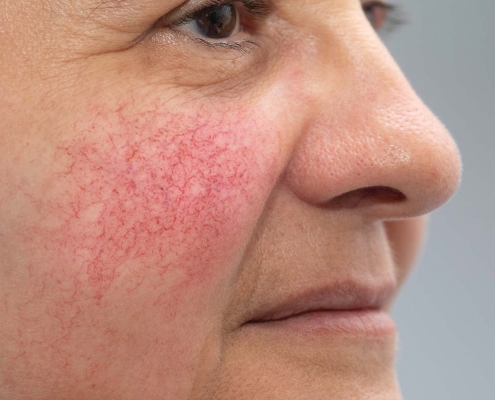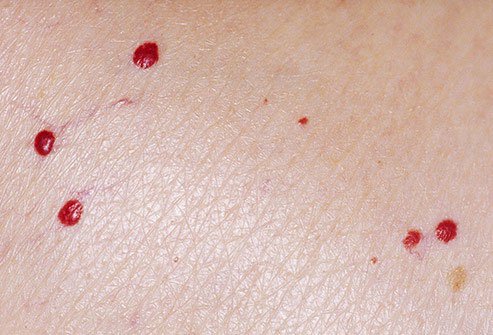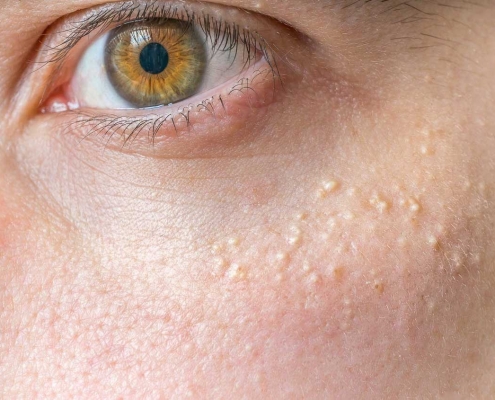Scarring from acne or other causes
Unfortunately, acne can leave behind damage and scarring on both the surface and deeper layers of the skin. Acne scars are permanent textured changes and indentations resulting from severe acne. However, the term ‘scarring’ is not used for the temporary red and brown marks that appear early after acne, as these are likely to improve over time.
There are various types of acne scars, and it’s common for individuals to have a combination, including tethered or anchored scars, ice pick scars, boxcar scars, and rolling scars.
Different types of scars necessitate different treatments, and a customized approach to scar revision often yields the best results. While there are many treatments available that can improve and soften the appearance of acne scars, a combination of treatments is often necessary.
Congested Skin
Congestion is a term used to describe skin which has clogged pores. These are seen as blackheads and whiteheads making the bumps and dirty look associated with it. Blackheads are when the clogged substance is close to the surface with the air making them appear black and whiteheads are the deeper ones, harder to treat and not accessible to the air.
The overall cause is, of course, those pesky hormones we all have, however why some people skins develop these problems and others don’t is due to a number of factors all of which contribute differently to the problem:
- A build-up of excess oil & sebum
- Dead cells which are produced constantly as our cells turnover
- Environmental pollution and daily dirt
- Toxins being expelled by the body via your sweat
- Makeup & Skincare
- Insufficient cleansing
- Products that are full of toxins such as petrochemicals, SLS & other nasty’s.
Genetics and lifestyle issues play an enormous part in how the hormones act on the skin and so the treatment plan has to revolve around these.
Treatment is slightly different to skin with pimples though as congestion often leads to pimples our overall plan is similar. What we aim for is to change the pH of the skin, keep it well hydrated, build its immunity, stimulate cell turnover and keep the skin scrupulously clean without damaging the surface layers. Harsh scrubs & cleansers simply cause inflammation, drying the skin and causing a rebound of oil production.
A tailored professional home care routine and in-clinic treatment plan will have you well on the way to clear, smooth, healthy glowing skin.
Ageing
Aging is an inevitable process, but Dermotique can assist you in aging more gracefully.
Our skin endures various challenges as we age, such as the sun, harsh weather, and poor habits. However, there are proactive measures we can take to keep our skin supple and youthful.
The aging of your skin is influenced by factors such as lifestyle, diet, genetics, and other personal habits. For example, smoking generates free radicals, which are oxygen molecules that have become overactive and unstable, leading to cell damage and, consequently, premature wrinkles.
Other prevalent causes of wrinkled and spotted skin include natural aging, sun exposure (photoaging), pollution, and the reduction of subcutaneous support (the fatty layer between skin and muscle). Additional factors affecting skin aging are stress, gravity, daily facial expressions, obesity, and even the position in which you sleep.
With age, the following changes naturally occur: the skin roughens, lesions such as benign tumors may develop, the skin slackens due to the loss of elastic tissue (elastin), causing it to hang loosely, the skin becomes more transparent due to the thinning of the epidermis, the skin grows more fragile as the connection between the epidermis and dermis flattens, and the skin bruises more easily because of thinner blood vessel walls.
Dermotique offers a variety of treatments and professional product lines to combat premature aging.
Enlarged Pores
Pores are the tiny, small openings in the skin at the top of our hair follicle, which cover our whole body. They release sebum (oils) to naturally moisturise and protect our skin.
Usually genetics determine larger pores. But oily skin, sun damaged and aging can also be factors.
As you grow older, your skin loses its elasticity, which causes your skin to stretch and sag, making pores appear larger. Your skin also thickens as you age, which causes skin cells to gather around your pores, making pores look bigger.
Years of sun damage can thicken the skin, which leads to bigger pores.
While you can’t change your pore size, you can minimise the appearance of enlarged pores.
And we offer a variety of treatments including Laser, Hydrafacials, peels and Micro needling to reduce the size of pores.
Dry Skin
Dry skin is a condition resulting from a lack of oil in the skin. Environmental factors, such as humidity and temperature, influence the skin’s moisture retention. Consequently, dry skin is more prevalent during the cold winter months and in arid climates.
Older individuals are more susceptible to dry skin as natural skin oils and lubricants decrease with age. A deficiency in proteins and lipids allows moisture to evaporate more readily, leading to increased sensitivity, rashes, and skin breakdown, which manifests as itching and roughness.
Improvements in dry skin can be achieved by taking lukewarm showers or baths and minimizing scrubbing, which can strip away the skin’s protective natural oils.
At Dermotique, we offer a variety of treatments and products designed to heal, repair, and fortify the skin barrier, ensuring your skin remains hydrated, soft, and healthy.
Dull Skin
Dull skin is precisely that—skin that has lost its vibrant color and luminosity and these skin cells require extra care.
As we age, our skin tends to become dry and dehydrated, leading to a lackluster appearance. Sun damage, a significant factor, occurs when UV rays harm the skin cells, potentially causing severe conditions like melanoma and contributing to a tired, dull look.
Lifestyle choices, including smoking, consuming unhealthy foods, insufficient sleep, inadequate exercise, excessive alcohol consumption, and not drinking enough water, can also lead to dull skin. Dehydration is another culprit; without adequate moisture, skin cells can look dull.
We offer solutions to rejuvenate your skin, remove dead cells, and restore your natural radiance.
Pigmentation
Whether it’s sun spots, age spots, freckles, sun damage, or melasma, skin pigmentation is a widespread concern. If left unaddressed, those small brown spots on your cheeks or nose can become problematic and unsightly. Hyperpigmentation is typically harmless but may sometimes signal an underlying health condition.
If these spots have appeared because you didn’t properly care for your skin, there are steps you can take to diminish them.
Skin pigmentation results from melanin, the pigment that colors our skin. Usually, melanin levels in our skin are stable, but hyperpigmentation involves an uneven distribution, leading to a mottled look. Common causes include sun damage, melasma, hormonal imbalances, or skin injuries.
Some pigmentation cases fall under “post-inflammatory hyperpigmentation,” presenting as dark spots on the face and neck from acne or other skin injuries. As the skin heals, melanin levels increase, and these spots can linger long after the initial injury.
Treating skin pigmentation can be challenging; it’s not as simple as peeling away sunspots. While generally harmless, some individuals opt for removal for cosmetic reasons.
Susceptibility to skin pigmentation varies, and its intensity can be influenced by lifestyle, genetics, and age.
For cosmetic concerns regarding skin pigmentation, consulting with professionals at Dermotique is advisable.
Broken Capillaries
Broken or dilated capillaries, tiny veins that can appear anywhere on the body, are most often seen on the face, particularly around the nose, cheeks, and chin. These spider veins, as they are commonly known, form just beneath the skin’s surface, creating a red, web-like appearance. They result from the rapid expansion and contraction of capillary walls, which can cause tearing and subsequent blood leakage.
Thin, dehydrated, dry, and sensitive skin types offer less protection and are more susceptible to these issues. Other contributing factors include genetics, sun exposure, weather changes, pressure fluctuations, pregnancy, environmental irritants, rosacea, alcohol consumption, and physical injuries.
Although these reddish, spider-like marks are not harmful, they can be quite noticeable and aesthetically displeasing.
Once formed, these broken vessels do not heal or fade away naturally. Our skilled therapists are trained to handle your skin with care during facials to prevent further damage.
Our clinic offers a variety of treatment options, such as LED therapy and vascular laser treatments.
Rosacea
Rosacea is an inflammatory skin condition primarily affecting the face, commonly the cheeks and nose, and to a lesser degree, the forehead and chin. It usually starts in adults between 30 and 60 years old and is more prevalent among those with fair skin, blue eyes, and Celtic origins.
The causes of rosacea may include genetic factors, environmental triggers, vascular issues, inflammation, or bacterial infections. Significant skin damage from chronic sun exposure is also a key factor.
The use of certain facial creams or oils, especially topical steroids, may aggravate the condition. Rosacea typically presents as red papules, sometimes with pustules, accompanied by scaling and swelling.
Symptoms often include frequent blushing or flushing, visible redness from dilated blood vessels (telangiectasia), and dry, flaky skin. It may worsen with sun exposure, or after consuming hot, spicy foods or drinks—essentially, anything that induces facial redness. Those with sensitive skin might also suffer from burning and stinging sensations, especially when applying makeup, sunscreens, or other facial products.
Managing rosacea typically involves a multifaceted treatment plan, including prescription medications, vascular laser and LED light therapies, and tailored professional homecare to meet the specific needs of your skin.
Moles
Moles are pigmented lesions that appear on your skin. They are usually round or oval in shape and can sometimes be raised from the skin. Most people have about 50 moles.
Most moles are mostly harmless, but some types can develop into skin cancer. This is usually caused by long periods of exposure to the sun.
It is important to get your moles checked regularly by your GP or Dermatologist.
Look out for any changes, including:
- The size, shape, colors or irregular outline of your moles.
- Any bleeding, soreness, itching, weeping or inflammation should be checked
- A crusty or flaky appearance developing, or new moles which look different or unusual
Warts
Warts are skin infections caused by the human papillomavirus (HPV). With over 100 types of HPV, they are responsible for various warts, including common, plantar, flat, and genital warts. Warts are especially common in children, with estimates suggesting that up to 20% of children, particularly those aged 12 to 16, have warts. Many warts resolve without medical treatment.
Most warts can be identified easily. However, for atypical warts, a doctor’s diagnosis is recommended.
There are numerous treatments available for warts. Due to their persistent nature, multiple treatments may be necessary. Laser therapy is an effective method for wart removal, although it may result in scarring.
Cherry Angiomas
Red moles, or cherry angiomas, are common skin growths that can develop in most areas of your body. They most often grow on the torso, arms, legs, and shoulders. They’re also known as senile angiomas or Campbell de Morgan spots.
A cherry angioma is often bright red due to the collection of small blood vessels inside the lesion. They are circular or oval in shape and ranging in size from a pinpoint to a few millimeters in diameter. Some cherry angiomas appear smooth and even with your skin, while others appear slightly raised.
Bleeding can occur if the angioma is scratched, rubbed, or cut open.
The exact cause of red moles is unknown, but there may be a genetic factor that makes certain people more likely to get them. They often begin to appear when individuals reach 30 years old and seem to increase in size and number with age.
You probably won’t need to have a cherry angioma treated, but you do have options if you want it removed for cosmetic reasons. A vascular laser is the most effective way to remove cherry angiomas. Depending on how many angiomas you have, you may need between one and three treatment sessions.
If you do have angiomas removed with any of these methods, scarring is uncommon but always possible.
A cherry angioma won’t go away on its own, but it’s also unlikely to cause you any problems. It may bleed from time to time if it’s irritated. However, a red mole that changes in size, shape, or color is always cause for concern and should be looked at by your primary care doctor or dermatologist.
Milia
Milia are small white benign bumps just under the surface of the skin. They most often appear on the face, and are particularly prominent on the eyelids and cheeks, but they can occur elsewhere. An individual milium is typically smaller than 1mm but can measure up to 3mm or more. They commonly occur on the faces of newborn babies, especially on the nose. Milia can also affect children and adults, with one type of milia causing pearly bumps around the eyes.
What causes milia?
Milia are a type of cyst containing dead skin cells (keratin). They are formed when flakes of keratin get trapped just below the skin’s surface. They are harmless and cause no symptoms.
Milia are easy to identify and can be diagnosed by a doctor without any need for testing.
Milia usually go away naturally without any treatment. They don’t leave scars and trying to squeeze or burst them at home is not recommended. In some cases, your doctor can remove milia by slicing off the top of individual cysts with a sterile blade or needle and squeezing them out.
We offer effective treatment options for the removal of milia.
Stretch Marks
Stretch marks are scar-like streaky areas that appear in overstretched skin. Underlying tissue expansion is the most common cause, so they develop most often during the growth spurt in adolescence and on the expanding abdomen in the third trimester of pregnancy.
They can also occur in bodybuilders, as a consequence of rapid weight gain, and in some medical conditions where the skin is exposed to excessive amounts of a hormone called cortisol. Early stretch marks are usually red or purple. Over time, stretch marks lose their colour and become white or silvery in appearance.
A stretch mark is formed when the skin is stretched as a consequence of underlying tissue expansion. There is an inflammatory reaction in the skin that is responsible for the characteristic red or purple colour. The inflammation eventually fades and is replaced by scar tissue. This produces a thinned epidermis, loss of dermal elastin, and a replacement of the dermis by abnormally dense collagen fibres. The scarring is characteristically white or silvery in appearance and permanent.
Evidence suggests that the application of creams and lotions can’t prevent stretch marks. However, some treatments have shown promise in individual studies.
Stretch marks naturally fade and usually become less conspicuous over time, so in many cases, treatment may not be necessary.
We have various effective treatments available for the management of red, purple or white stretch marks.
Your skin deserves Dermotique!
We are dedicated to delivering the finest skin care and resolving issues where others have not succeeded.
Our goal is to offer you professional services and effective treatments, backed by our unmatched expertise in skin health.
Reach out to us now to book a consultation with our expert skin therapists—your skin is worth it!
Please note that consultation fees are applicable.
















